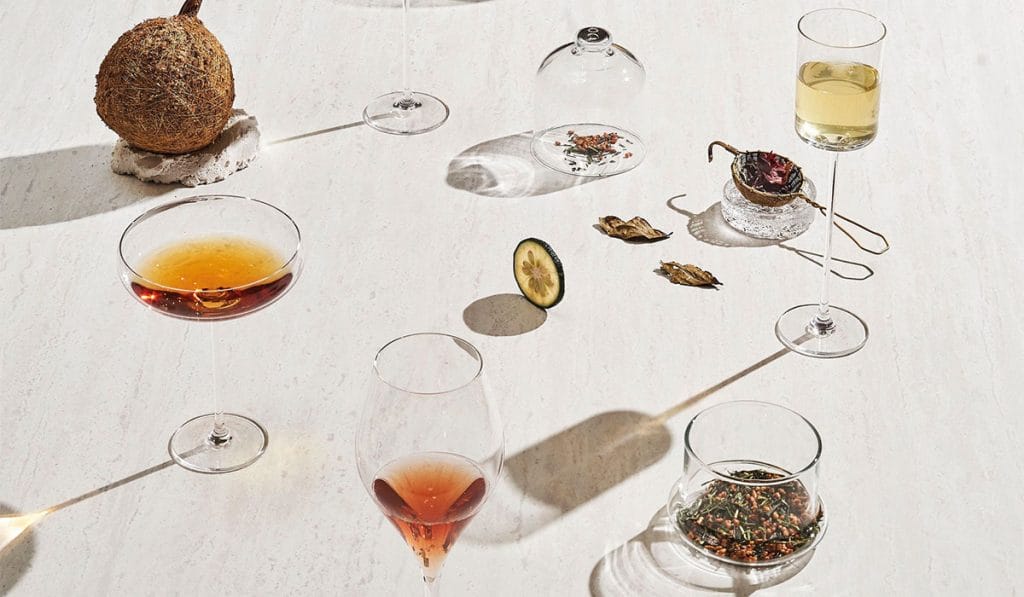Degustation dinners paired with libations are often decadent affairs that leave one heady from long flights of wine, and a little groggy-headed the day after. But not at Esora. The fine-dining Japanese restaurant that opened last August offers not just a wine pairing menu, but also one where every course is matched with tea.
Chef-owner Shigeru Koizumi goes to great lengths to deliver a tea programme with a difference. Only the best teas of the season are sourced – just as a chef sources prime seasonal ingredients for his menu. “The teas are sourced through my personal relationships with suppliers, who have direct connections with tea plantation owners and farmers. While most establishments either source their leaves from commercial suppliers or have external producers curate their tea list, I wanted to ensure the quality and consistency of the teas from farm to cup,†says Koizumi.
Tea Party
The prized leaves are blended in small batches daily and the brews are strained into clear bottles to showcase the different hues. They are served either cold or warm, depending on the character of the tea leaves and dish. For example, a blend of iribancha (smoky green tea), hojicha (roasted green tea) and cinnamon is brewed at 60 deg C to bring out its smoky flavours that complement a rich dish of omi wagyu.
Modern stemware rather than cups are used. Think a champagne flute for the tohou bijin oolong blend – “the narrow rim focuses the floral aroma of hibiscus and plum to the noseâ€, explains Koizumi. “A chardonnay glass could be used for the extremely aromatic kinsen oolong tea, where the larger bowl allows for air to enter and coax the creamy notes.â€
While cold brewed teas are well served by the glassware, the thin walls of the vessels are unable to retain heat from the warm teas as effectively as traditional porcelain tea vessels. In this instance, aesthetic form appears to trump function.
Given that tea, like wine, is a seasonal product of terroir and climate, and equally nuanced in taste and with a flavour spectrum suited for pairing with a variety of dishes – it works as a natural accompaniment to food. In Singapore, French fine-dining restaurant Beni also has a tea pairing menu featuring luxe brews. Elsewhere, Michelin-star establishments such as Atera in New York and Club Gascon and Fera At Claridge’s in London have also been serving up tea pairing menus for the last few years.
Indeed, tea pairing is not completely new. Singaporean tea entrepreneur and founder of Gryphon Tea Lim Tian Wee shares that he has been designing tea programmes and training tea sommeliers for F&B outfits for the last decade, though tea pairing meals as a regular offering is a recent development. “Diners today seem to lean towards lighter tastes. The benefits that come with drinking tea also appeal to the health-conscious,†says Lim.
Highlighting the similarities between wine and tea tastings, he thinks it is not unfathomable for someone who enjoys wine with his meals to also appreciate how teas can augment the dining experience. “I have had attendees of tea pairing meals tell me that they didn’t think it was possible to go through dinner without wine, and yet found the experience thoroughly refreshing,†he says.
“That said, I don’t think teas are going to replace wines,†adds Lim. Not for those who can’t handle even a wee dose of caffeine after 3pm, at least.
Blend in to stand out
Some unusual blends featured on Esora’s tea pairing menu.

GLASS ACT At Esora, tea is served in modern stemware instead of traditional porcelain cups.
TOHOU BIJIN + HIBISCUS
Sourced from Hsinchu in Taiwan, this oolong is blended with an umeshu reduction and hibiscus petals. The result is a tea with a deep rosy hue and subtle floral acidity. Usually served at the start of a meal, the tea is also carbonated to make a playful replacement of the usual bubbly component in an alcoholic pairing.
IRIBANCHA + HOJICHA
A daily cuppa for Kyotoites, iribancha is a smoky green tea made from roasting the leaves, stems and twigs from the tea plant after the first picking of the year. This is blended with hojicha, another roasted green tea that also boasts toasty flavours. A touch of cinnamon is added to lift the flavours.
GENMAICHA + BASIL
Basil, usually added to savoury dishes, is blended with genmaicha to unexpected effect. Lifted by the aromatic herb, the Japanese green tea with roasted popped brown rice kernels makes an earthy, toasty yet refreshing accompaniment to seasonal sashimi.



